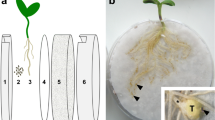Summary
The extent of blocking of sieve-plate pores caused by release of cell turgor was investigated by fixing and processing for electron microscopy a long length of celery (Apium graveolens L.) phloem. Differences in distribution of P-protein within the pores were observed between those cells near the two cut ends, and the central cells.
To assess the effect of chemical fixation on the distribution of P-protein, strands of celery phloem (fixed or unfixed, and not treated with cryoprotectants) were frozen in Freon 12 and then freeze-substituted. In sieve elements from unfixed tissue there were a greater number of sieve plates displaying partially open pores.
Direct freezing of unprotected phloem tissue in Freon 12 resulted in the formation of ice crystals within the lumen of the sieve elements. Freezing of tissue at rates fast enough to avoid the formation of damaging ice crystals resulted in sieve-plate pores having an unoccluded central channel with a peripheral lining of P-protein. In the lumen of the sieve elements the P-protein filaments occurred as discrete bundles ca. 0.5 μm in diameter, and as a parietal layer varying in thickness from 0.1 to 0.5 μm.
Similar content being viewed by others
References
Allen, N. S.: Endoplasmic filaments generate the motive force for rotational streaming in Nitella. J. Cell Biol. 63, 270–287 (1974)
Anderson, R., Cronshaw, J.: Sieve-plate pores in tobacco and bean. Planta (Berl.) 91, 173–180 (1970)
Baker, R. F.: Freeze-thawing as a preparatory technique for electron microscopy. J. Ultrastruct. Res. 7, 173–184 (1962)
Cronshaw, J., Anderson, R.: Sieve plate pores of Nicotiana. J. Ultrastruct. Res. 27, 134–148 (1969)
Dempsey, G. P.: Ultrastructural preservation related to rapidity of freezing. Proc. VIII Int. Congr. Electron Microscopy, Canberra, Australia, vol. II, p. 42–43 1974
Evert, R. F., Eschrich, W., Eichhorn, S. E.: P-protein distribution in mature sieve elements of Cucurbita maxima. Planta (Berl.) 109, 193–210 (1973)
Fensom, D. S., Williams, E. J.: On Allen's suggestion for long-distance translocation in phloem of plants. Nature (Lond.) 250, 490–492 (1974)
Hereward, F. V., Northeote, D. H.: A simple freeze-substitution method for the study of ultrastructure of plant tissues. Exp. Cell Res. 70, 73–80 (1972)
Jarvis, P., Thaine, R.: Strands in sections of sieve elements cut in a cryostat. Nature (Lond.) New Biol. 232, 236–237 (1971)
Jarvis, P., Thaine, R., Leonard, J. W.: Structures in sieve elements cut with a cryostat following different rates of freezing. J. exp. Bot. 24, 905–919 (1973)
Johnson, R. P. C.: Microfilaments in pores between frozen-etched sieve elements. Planta (Berl.) 81, 314–332 (1968)
Johnson, R. P. C.: Filaments but no membranous transcellular strands in sieve pores in freeze-etched, translocating phloem. Nature (Lond.) 244, 464–466 (1973)
Mishra, U., Spanner, D. C.: The fine structure of the sieve tubes of Salix caprea (L.) and its relation to the electro-osmotic theory. Planta (Berl.) 90, 43–56 (1970)
Siddiqui, A. W., Spanner, D. C.: The state of the pores in functioning sieve plates. Planta (Berl.) 91, 181–189 (1970)
Spurr, A. R.: A low-viscosity epoxy resin embedding medium for electron microscopy. J. Ultrastruct. Res. 26, 31–43 (1969)
Thaine, R.: A translocation hypothesis based on the structure of plant cytoplasm. J. exp. Bot. 13, 152–160 (1962)
Thaine, R.: Movement of sugars through plants by cytoplasmic pumping. Nature (Lond.) 222, 873–875 (1969)
Thaine, R., De Maria, M. E.: Transcellular strands of cytoplasm in sieve tubes of Squash. Nature (Lond.) 245, 161–163 (1973)
Van Harreveld, A., Crowell, J.: Electron microscopy after rapid freezing on a metal surface and substitution fixation. Anat. Rec. 149, 381–385 (1964)
Weatherley, P.: Translocation in sieve tubes. Some thoughts on structure and mechanism. Physiol. vég. 10, 731–742 (1972)
Author information
Authors and Affiliations
Rights and permissions
About this article
Cite this article
Dempsey, G.P., Bullivant, S. & Bieleski, R.L. The distribution of P-Protein in mature sieve elements of celery. Planta 126, 45–59 (1975). https://doi.org/10.1007/BF00389359
Received:
Accepted:
Issue Date:
DOI: https://doi.org/10.1007/BF00389359




